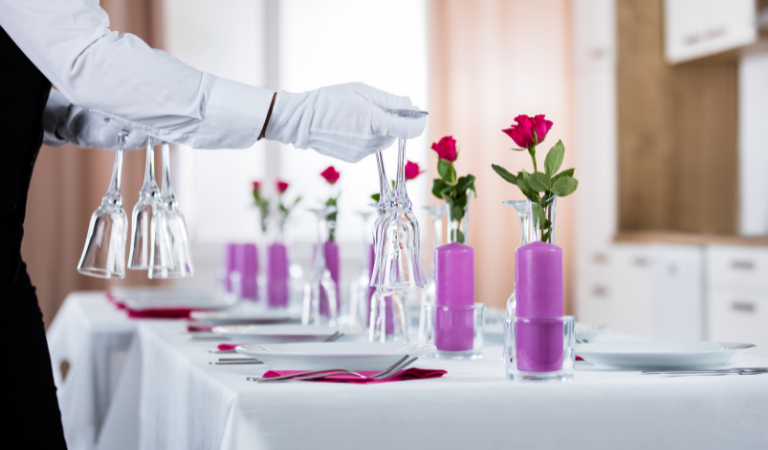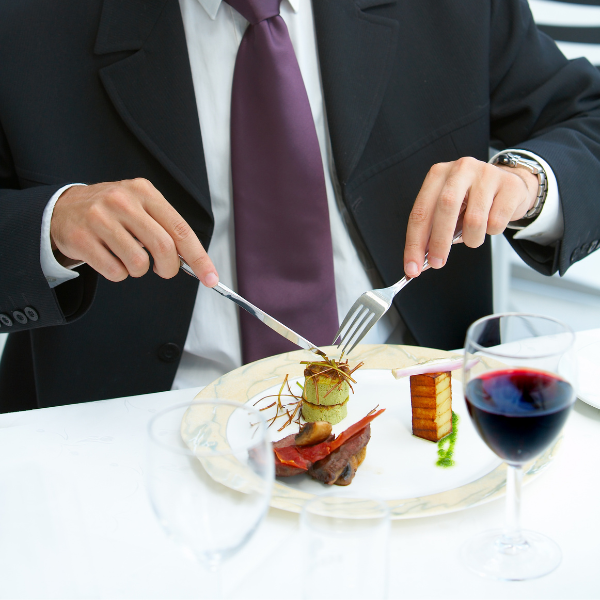The goal of every fine dining establishment is to provide patrons with an enjoyable and memorable dining experience. Most restaurants believe they can achieve this by simply creating an elegant ambiance and offering aesthetically plated full-course meals. However, what makes your customers feel like they’re getting their money’s worth is by offering the highest level of customer service.
Every patron dining at an upscale restaurant expects servers to follow proper serving etiquette. They want servers to make them feel welcomed and provide them with exceptional service while remaining unobtrusive during their meal. Whether you’re a new or experienced server, our informative guide provides you with the top 5 server etiquette tips to be a successful fine dining waiter.
1. Set The Dining Table Correctly
As a server, one of your responsibilities is to prepare dining tables for service. While it may sound as simple as setting a few plates and utensils for each place setting, there is a strategic way to put tables in order at upscale establishments. Properly setting tables enhances the ambiance of the restaurant while allowing you to easily serve patrons. Below are some helpful tips on how to set a formal dining table.
Consider Each Course
When setting a table, consider the number of courses that will be served. Each course requires its own silverware, so set place settings based on the number of courses your clients will have. For instance, if you’re serving a 3-course meal, place settings should include utensils for the appetizer, main course, and dessert.
You should also consider the beverages that will be offered. If you will be serving wine and water, each place setting should include a wine glass and water goblet. You shouldn’t set tables with any silverware, dinnerware, or glassware that guests will not need during their full-course dinner. It takes up additional space and may confuse guests as to which utensils they should use to enjoy each course.
Charger Plate
Charger plates are the first thing you set on the table. Chargers are set in the middle of each place setting and an inch away from the bottom edge of the table. They separate forks from knives and spoons and are found below the drinkware. You can place table accessories such as menu cards and linens on top of the chargers, as they are the first thing customers often look for when they are seated.
Silverware
Forks are placed on the left side of the charger while knives and spoons are on the right. The utensils are also set in a particular order: forks, spoons, and knives used first are placed on the outside and the silverware used last goes on the inside. If desserts will be served, set the utensils directly above the charger and parallel to the edge of the table.
Note: The cutting edge of the knife should always be facing the charger.
Glassware
Drinking glasses are placed to the upper right of the charger plate. The water glass is set first and should be directly above the main course knife and at the height of the dessert cutlery. Wine glasses and champagne flutes should follow and be placed to the lower right of the water goblet, creating a line of drinkware. If tea is being served, the teacup and saucer should be set to the right of the spoons and knives.
Note: When handling glassware, use gloves or hold them
by the stem to prevent them from getting fingerprints.
2. Anticipate Your Guests’ Needs
Formal dining servers' goal is to elevate their guests’ dining experience by providing exceptional hospitality. Servers can easily do this by being observant and detail-oriented. Every party you serve is different, making it essential to follow this step-by-step guide on how to anticipate your guests’ needs:
- Present the menu: If menus aren’t already set on the charger, wait for guests to be situated in their seats to provide them with the menu. Inform them that you will be back in a few minutes to take their drink orders and give them details of the specials.
- Inform them of specials: When you notice that there isn’t a lot of conversation going on at the table, inform guests of today’s specials and answer any questions they may have. You can also take their drink orders if they’re ready or provide them with a few more minutes.
- Take their order: When you notice that patrons are no longer looking at the menu and have placed it on the table, go and take their order.
- Control the tempo: Read the table and match the pace of your patrons throughout their dining experience. For instance, if you notice that guests are laughing and in deep conversation, once they’ve finished all of their courses, do not rush to provide them with the check. Wait for them to finish their conversations. Read their body language to determine if they are in a hurry or want to enjoy their time at the table.
3. Properly Clear The Table
 Servers should wait for all of the guests to finish the
course before clearing plates, flatware, and condiments. You can tell if
guests have finished their meal by observing their flatware. If their
silverware is placed on the plate in a cross or vertical position, that
is a signal that they are done and ready for the next course. Some
patrons you are serving may not be familiar with this fine dining rule
which also makes it important to look at their napkins. If you see their
napkin is on the table, they are indicating that they are finished.
Servers should wait for all of the guests to finish the
course before clearing plates, flatware, and condiments. You can tell if
guests have finished their meal by observing their flatware. If their
silverware is placed on the plate in a cross or vertical position, that
is a signal that they are done and ready for the next course. Some
patrons you are serving may not be familiar with this fine dining rule
which also makes it important to look at their napkins. If you see their
napkin is on the table, they are indicating that they are finished.
Rather than stacking dishes when clearing the table, you should remove each plate from the table individually and stack it on a tray out of the patrons’ sight. Stacking plates at the table can cause a commotion, increase noise levels, and lead to a dish breaking.
If you notice that crumbs are leftover from the course as you’re clearing the table, use a table crumber or folded napkin to remove them. You should swipe the crumbs onto a napkin or small plate. You should never use your hands to swipe or catch the crumbs. It doesn’t look professional and may cause guests to think that the establishment doesn’t follow safe food handling and sanitation practices.
4. Follow Fine Dining Serving Rules
Each catering company or upscale restaurant you work for will have specific table serving etiquette that you need to follow. Those fine dining serving rules are likely adopted from long-established serving traditions. Below is a list of answers to common questions servers may have when starting to work at a fine dining establishment.
Which Side Do You Serve From?
In America, meals are typically served to the guest’s right side. When serving, you will want to hold and serve the plate using your right hand to prevent you from crossing your arm in front of a guest. Since beverages are placed on the right side of guests, you will also want to serve beverages from the right.
Which Side Do You Clear Plates From?
Plates are cleared from the guest’s right side using your right hand to prevent you from crossing your arms. You will follow a clockwise order around the table using the same method.
Are Ladies Always Served First?
Traditionally, ladies are served first for each course. You will serve
the oldest lady present and move clockwise around the table. Then, you
will serve the gentlemen following the clockwise motion. It’s a standard
that has been known to be polite and proper for years and many
establishments still follow this service rule. However, some upscale
restaurants have abandoned this practice and have implemented a
gender-neutral service by simply serving patrons based on their seating
numbers. They believe that this is a more thoughtful and modern way to
serve patrons and makes it easier to serve large parties.
5. Look & Act Professional
Servers need to carry themselves in a poised manner and look presentable. Doing so makes guests feel welcomed while adding to the elegance of the catered event or foodservice establishment. Here are some basic principles to follow to ensure you look and act professionally:
- Wear a clean uniform: Your uniform shouldn’t have any stains or wrinkles. If your shirt or pants gets dirty while you’re working, you should change into a clean uniform to keep a professional look.
- Stay well-groomed: Your hair should be pulled back from the face, nails should be trimmed, and you shouldn’t wear any jewelry. Doing so ensures that you look presentable.
- Watch your posture: You want to avoid crossing your arms, putting your hands in your pocket, or slouching. Doing any of these things while serving customers may come off as you are bothered and not interested in serving them.
- Refrain from chewing gum: You should never chew gum while serving customers. It is considered rude and unsanitary.








